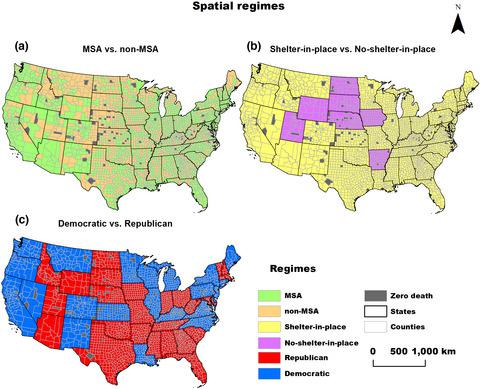Our official English website, www.x-mol.net, welcomes your feedback! (Note: you will need to create a separate account there.)
Exploring the socioeconomic drivers of COVID-19 mortality across various spatial regimes
The Geographical Journal ( IF 3.384 ) Pub Date : 2022-03-13 , DOI: 10.1111/geoj.12436 George Grekousis 1, 2, 3 , Yi Lu 4 , Ruoyu Wang 5
The Geographical Journal ( IF 3.384 ) Pub Date : 2022-03-13 , DOI: 10.1111/geoj.12436 George Grekousis 1, 2, 3 , Yi Lu 4 , Ruoyu Wang 5
Affiliation

|
Identifying the socioeconomic drivers of COVID-19 deaths is essential for designing effective policies and health interventions. However, how the significance and impact of these factors varies across different spatial regimes has been scantly explored. In this ecological cross-sectional study, we apply the spatial lag by regimes regression model to examine how the socioeconomic and health determinants of COVID-19 death rate vary across (a) metropolitan vs. non-metropolitan, (b) shelter-in-place vs. no-shelter-in-place order, and (c) Democratic vs. Republican US counties. A total of 20 variables were studied across 3108 counties in the contiguous US for the first year of the pandemic (6 February 2020 to 5 February 2021). The results show that the COVID-19 death rate not only depends on a complex interplay of the population demographic, socioeconomic and health-related characteristics, but also on the spatial regime that the residents live, work and play. Household median income, household size, percentage of African Americans, percentage aged 40–59 and heart disease mortality are significant to metropolitan but not to non-metropolitan counties. We identified lack of insurance access as a significant driver across all regimes except for Democratic. We also showed that the political orientation of the governor might have impacted COVID-19 death rates due to the public response (i.e., shelter-in-place vs. no-shelter-in-place order). The proposed analysis allows for understanding the socioeconomic context in which public health policies can be applied, and importantly, it presents how COVID-19 death related factors vary across different spatial regimes.
中文翻译:

探索各种空间制度下 COVID-19 死亡率的社会经济驱动因素
确定 COVID-19 死亡的社会经济驱动因素对于设计有效的政策和健康干预措施至关重要。然而,这些因素的重要性和影响如何在不同的空间状态下发生变化的研究很少。在这项生态横断面研究中,我们应用空间滞后按制度回归模型来检查 COVID-19 死亡率的社会经济和健康决定因素如何在 (a) 大都市与非大都市之间变化,(b) 避难所地方与无就地庇护令,以及 (c) 民主党与共和党美国县。在大流行的第一年(2020 年 2 月 6 日至 2021 年 2 月 5 日),共研究了美国毗邻 3108 个县的 20 个变量。结果表明,COVID-19 死亡率不仅取决于人口统计的复杂相互作用,与社会经济和健康相关的特征,还取决于居民生活、工作和娱乐的空间制度。家庭收入中位数、家庭规模、非洲裔美国人的百分比、40-59 岁的百分比和心脏病死亡率对大都市县很重要,但对非大都市县则不重要。我们发现,除了民主党之外,所有政权都缺乏保险渠道是一个重要驱动因素。我们还表明,由于公众的反应(即就地避难与不就地避难令),州长的政治取向可能会影响 COVID-19 死亡率。拟议的分析有助于了解可以应用公共卫生政策的社会经济背景,重要的是,它展示了 COVID-19 死亡相关因素如何在不同的空间制度下发生变化。
更新日期:2022-03-13
中文翻译:

探索各种空间制度下 COVID-19 死亡率的社会经济驱动因素
确定 COVID-19 死亡的社会经济驱动因素对于设计有效的政策和健康干预措施至关重要。然而,这些因素的重要性和影响如何在不同的空间状态下发生变化的研究很少。在这项生态横断面研究中,我们应用空间滞后按制度回归模型来检查 COVID-19 死亡率的社会经济和健康决定因素如何在 (a) 大都市与非大都市之间变化,(b) 避难所地方与无就地庇护令,以及 (c) 民主党与共和党美国县。在大流行的第一年(2020 年 2 月 6 日至 2021 年 2 月 5 日),共研究了美国毗邻 3108 个县的 20 个变量。结果表明,COVID-19 死亡率不仅取决于人口统计的复杂相互作用,与社会经济和健康相关的特征,还取决于居民生活、工作和娱乐的空间制度。家庭收入中位数、家庭规模、非洲裔美国人的百分比、40-59 岁的百分比和心脏病死亡率对大都市县很重要,但对非大都市县则不重要。我们发现,除了民主党之外,所有政权都缺乏保险渠道是一个重要驱动因素。我们还表明,由于公众的反应(即就地避难与不就地避难令),州长的政治取向可能会影响 COVID-19 死亡率。拟议的分析有助于了解可以应用公共卫生政策的社会经济背景,重要的是,它展示了 COVID-19 死亡相关因素如何在不同的空间制度下发生变化。



























 京公网安备 11010802027423号
京公网安备 11010802027423号